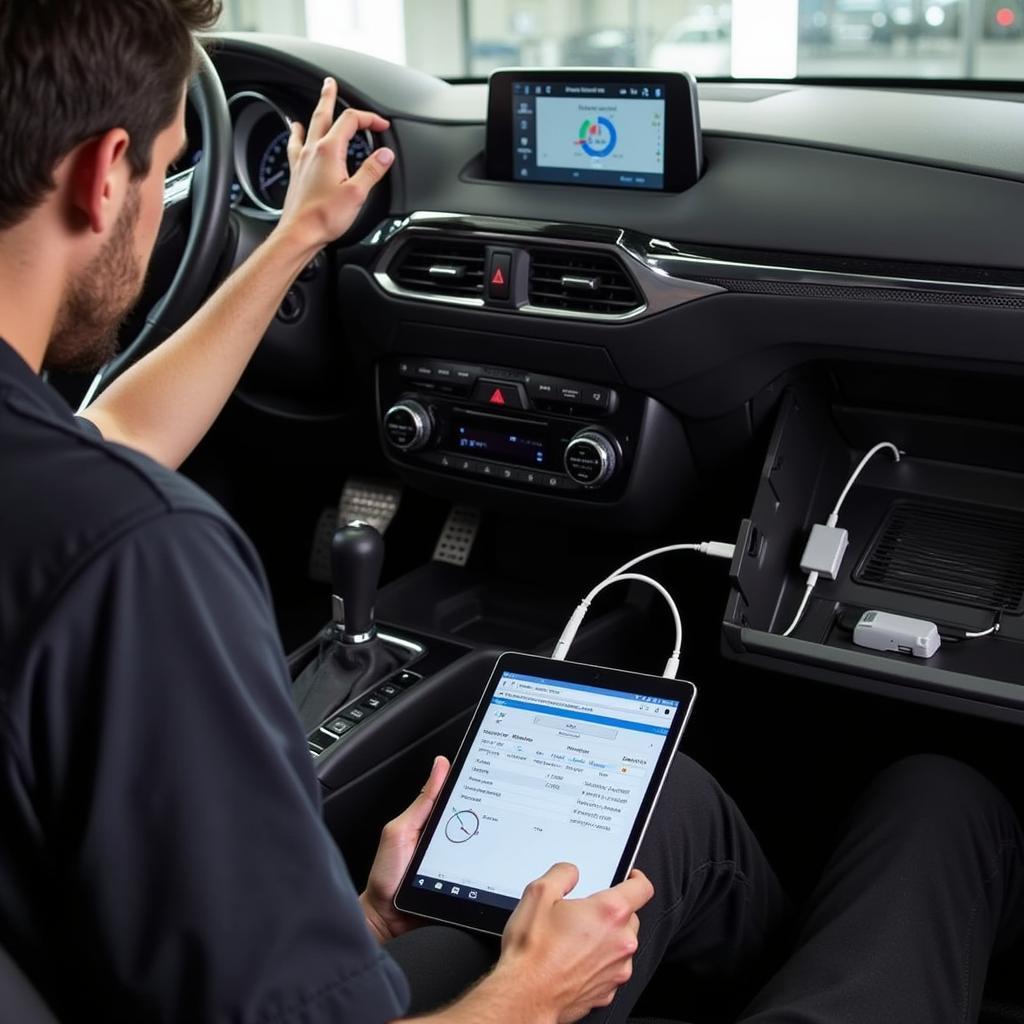The 2018 Mazda CX-5 is known for its sleek design and enjoyable driving experience. However, like any vehicle, it can encounter issues. One such issue is the dreaded brake assist warning light. If you’re seeing this warning light illuminate on your dashboard, don’t panic. This article will guide you through the potential causes, troubleshooting steps, and solutions for the 2018 Mazda CX-5 brake assist warning.
Understanding Brake Assist in Your Mazda CX-5
Before delving into the warning light, it’s important to grasp the fundamentals of the brake assist system. This sophisticated safety feature acts as your co-pilot in emergency braking situations. It senses rapid and forceful brake pedal application, interpreting it as a panic stop. In these critical moments, the system automatically applies maximum braking force, potentially preventing a collision.
Common Causes of the Brake Assist Warning Light
There are several reasons why the brake assist warning light might illuminate on your 2018 Mazda CX-5:
- Low Brake Fluid: Brake fluid is the lifeblood of your braking system. If the fluid level is low, it can trigger the brake assist warning light.
- Faulty Brake Sensor: Your CX-5 is equipped with sensors that monitor various components of the braking system. A malfunctioning sensor can disrupt the system’s functionality and activate the warning light.
- Issue with the Brake Control Module: The brake control module is the brain of your braking system. If this module experiences electrical or software problems, it can lead to the brake assist warning light.
- Problem with the Brake Booster: The brake booster amplifies the force you apply to the brake pedal, making braking easier. A faulty brake booster can compromise braking performance and trigger the warning light.
Troubleshooting the Brake Assist Warning Light
If the brake assist warning light appears on your dashboard, here’s a step-by-step guide to help you troubleshoot the issue:
- Check Your Brake Fluid Level: Park your CX-5 on a level surface and turn off the engine. Locate the brake fluid reservoir under the hood (refer to your owner’s manual for its exact location). Carefully remove the reservoir cap and check the fluid level. If it’s low, add the recommended brake fluid type until it reaches the “MAX” line.
- Inspect Your Brakes: Visually inspect your brake pads and rotors for excessive wear and tear. If you notice any significant damage or thinning of the brake pads, it’s crucial to have them replaced by a qualified mechanic.
“Regular brake maintenance is essential for safety,” advises Jason Parker, a seasoned automotive technician with over 15 years of experience. “Don’t ignore warning signs like the brake assist light. Addressing them promptly can prevent more significant issues down the road.”
When to Seek Professional Help
While the steps above can help identify simple issues, it’s crucial to remember that the brake system is complex and critical for your safety. If you’re uncomfortable troubleshooting or suspect a more complex problem, seeking professional assistance is essential.
Here are instances where professional help is recommended:
- Warning Light Remains On: If the brake assist warning light remains illuminated after checking the brake fluid and inspecting your brakes, it’s best to consult a qualified mechanic.
- Unusual Noises: Grinding, squeaking, or other unusual noises emanating from your brakes warrant immediate attention from a professional.
- Changes in Brake Pedal Feel: If you notice your brake pedal feeling spongy, soft, or requiring more pressure than usual, it’s crucial to have your braking system inspected by a mechanic without delay.
Advanced Diagnostics and Remote Software Solutions
In many cases, diagnosing the root cause of the brake assist warning light requires specialized diagnostic equipment. Experienced technicians can connect to your CX-5’s onboard computer to retrieve diagnostic trouble codes (DTCs), providing valuable insights into the issue.
“Modern vehicles like the 2018 CX-5 are equipped with sophisticated electronics,” explains Sarah Chen, a leading automotive software engineer. “Remote software updates and calibrations can sometimes address certain brake assist issues, providing a convenient and efficient solution.”
 Remote Diagnostics and Software Updates for 2018 Mazda CX-5
Remote Diagnostics and Software Updates for 2018 Mazda CX-5
Conclusion
The brake assist warning light in your 2018 Mazda CX-5 is a crucial safety indicator that should never be ignored. While some causes can be addressed with simple checks, seeking professional help is often the safest course of action. By understanding the potential causes and taking appropriate steps, you can ensure the optimal performance and reliability of your CX-5’s braking system, keeping you and your passengers safe on the road.

